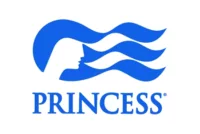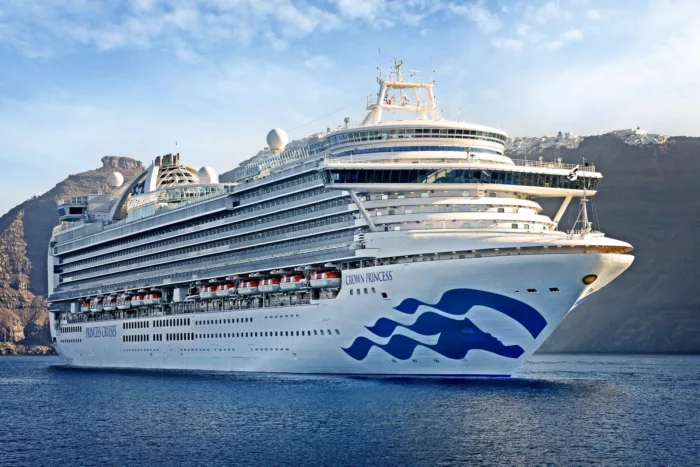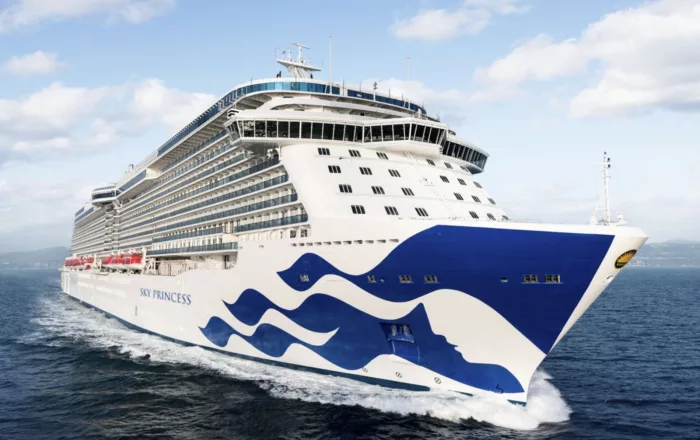
Princess Cruises
Credited with introducing millions of Americans to the concept of a modern cruise holiday, Princess Cruises is still innovating to this day.
Sporting a fleet of 17 ships with capacities ranging from 2,000 to 4,300 passengers, the line is best known for its Alaskan cruises, but travels to destinations the world over.
With an emphasis on destination leadership and local expertise, Princess is an excellent choice for the discerning traveller seeking to sail in comfort.
3080
Passengers
1200
Crew
2006
Launched
2018
Last refit
113561t
Tonnage
290m
Length
49m
Width
22kts
Speed
15
Decks
USD
Currency
Cruise Itinerary
Day 1
Dover, England
Day 2
At Sea
Relax and make the most of the myriad of facilities available on board the ship, from fantastic entertainment to delicious and diverse dining options.
Day 3
Bergen, Norway
Day 4
Skjolden, Norway
Days 5 - 6
At Sea
Relax and make the most of the myriad of facilities available on board the ship, from fantastic entertainment to delicious and diverse dining options.
Day 7
Honningsvåg, Norway
Days 8 - 10
At Sea
Relax and make the most of the myriad of facilities available on board the ship, from fantastic entertainment to delicious and diverse dining options.
Day 11
Reykjavík, Iceland
Day 12
Isafjørdur, Iceland
Wheelchair Access Limited
Days 13 - 14
At Sea
Relax and make the most of the myriad of facilities available on board the ship, from fantastic entertainment to delicious and diverse dining options.
Day 15
Nanortalik, Greenland
Wheelchair Access Limited
Day 16
Qaqortoq (Julianehaab), Greenland
Wheelchair Access Limited
Days 17 - 19
At Sea
Relax and make the most of the myriad of facilities available on board the ship, from fantastic entertainment to delicious and diverse dining options.
Day 20
Halifax, Nova Scotia, Canada
Day 21
At Sea
Relax and make the most of the myriad of facilities available on board the ship, from fantastic entertainment to delicious and diverse dining options.
Days 22 - 23
New York, New York, United States
Days 24 - 25
At Sea
Relax and make the most of the myriad of facilities available on board the ship, from fantastic entertainment to delicious and diverse dining options.
Day 26
Miami, Florida, United States
Days 27 - 28
At Sea
Relax and make the most of the myriad of facilities available on board the ship, from fantastic entertainment to delicious and diverse dining options.
Day 29
Cartagena, Colombia
Day 30
,
Days 31 - 33
At Sea
Relax and make the most of the myriad of facilities available on board the ship, from fantastic entertainment to delicious and diverse dining options.
Days 34 - 35
Callao, Peru
Day 36
General San Martin, Peru
Days 37 - 40
At Sea
Relax and make the most of the myriad of facilities available on board the ship, from fantastic entertainment to delicious and diverse dining options.
Day 41
Hangaroa, Easter Island, Chile
Days 42 - 43
At Sea
Relax and make the most of the myriad of facilities available on board the ship, from fantastic entertainment to delicious and diverse dining options.
Day 44
Pitcairn Island, Pitcairn
Days 45 - 46
At Sea
Relax and make the most of the myriad of facilities available on board the ship, from fantastic entertainment to delicious and diverse dining options.
Days 47 - 48
Papeete, Tahiti, French Polynesia
Day 48
Moorea, French Polynesia
Wheelchair Access Limited
Days 49 - 54
At Sea
Relax and make the most of the myriad of facilities available on board the ship, from fantastic entertainment to delicious and diverse dining options.
Day 55
Auckland, New Zealand
Days 56 - 58
At Sea
Relax and make the most of the myriad of facilities available on board the ship, from fantastic entertainment to delicious and diverse dining options.
Day 59
Sydney, New South Wales, Australia

Day 1
Dover, England

Day 2
At Sea

Day 3
Bergen, Norway

Day 4
Skjolden, Norway

Days 5 - 6
At Sea

Day 7
Honningsvåg, Norway

Days 8 - 10
At Sea

Day 11
Reykjavík, Iceland

Day 12
Isafjørdur, Iceland

Days 13 - 14
At Sea

Day 15
Nanortalik, Greenland

Day 16
Qaqortoq (Julianehaab), Greenland

Days 17 - 19
At Sea

Day 20
Halifax, Nova Scotia, Canada

Day 21
At Sea

Days 22 - 23
New York, New York, United States

Days 24 - 25
At Sea

Day 26
Miami, Florida, United States

Days 27 - 28
At Sea

Day 29
Cartagena, Colombia

Day 30
,

Days 31 - 33
At Sea

Days 34 - 35
Callao, Peru

Day 36
General San Martin, Peru

Days 37 - 40
At Sea

Day 41
Hangaroa, Easter Island, Chile

Days 42 - 43
At Sea

Day 44
Pitcairn Island, Pitcairn

Days 45 - 46
At Sea

Days 47 - 48
Papeete, Tahiti, French Polynesia

Day 48
Moorea, French Polynesia

Days 49 - 54
At Sea

Day 55
Auckland, New Zealand

Days 56 - 58
At Sea

Day 59
Sydney, New South Wales, Australia
Ship Details


Princess Cruises
Crown Princess
Your escort to a world of dazzling amenities, sublime dining options and exotic destinations
Enjoy sweeping views of the world while sailing on Crown Princess.
Cabins
All Prices

















